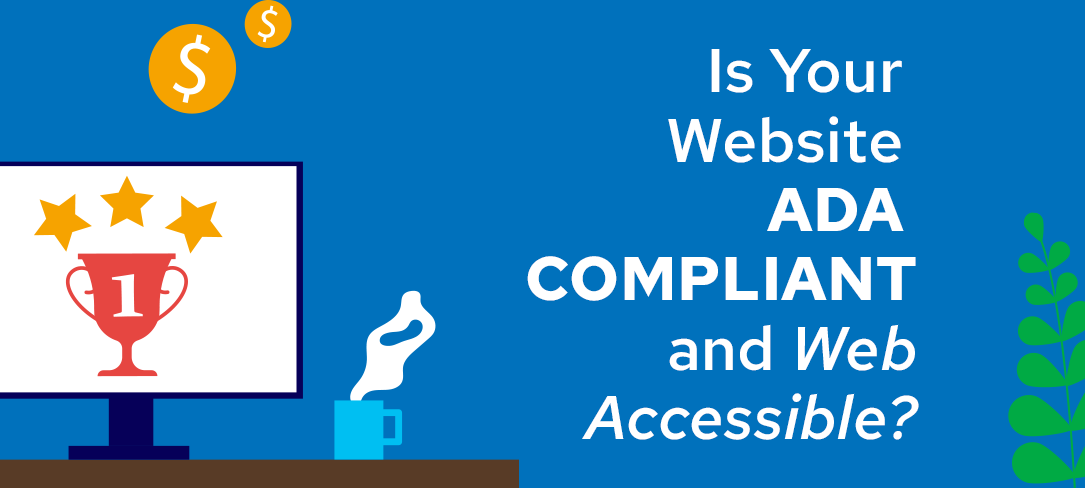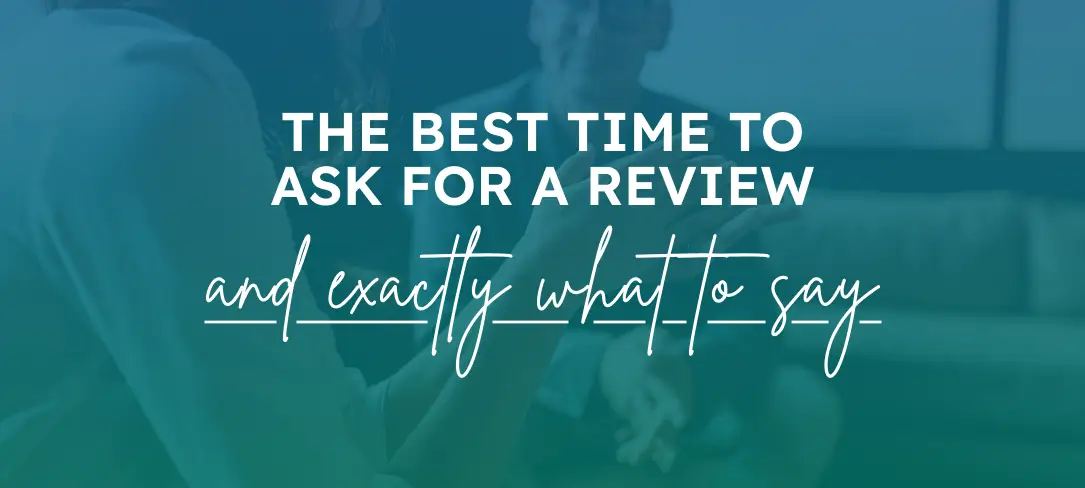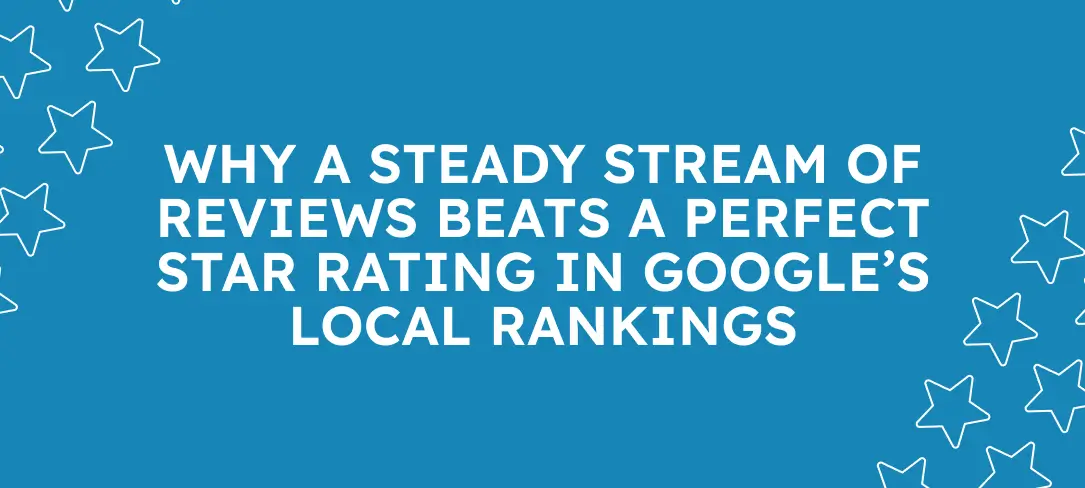A Guide for Property Managers
Web Accessibility Statistics
In February 2020, WebAIM conducted an accessibility evaluation of the home pages for the top 1,000,000 websites on the Internet. Of this, 98.1% of website home pages had detectable WCAG 2 failures!
As of 2020, there are over 400 million active websites hosted on the Internet. Any of those websites that do business in the United States are legally required to provide equal accessibility to all people following Title III of the Americans with Disabilities Act.
To be ADA-compliant, your property management website must be free of barriers that would make it difficult or impossible for people with disabilities to make use of them. Having an inaccessible website can grow into a major source of problems and missed opportunities for your business.
A lack of accessibility compliance can lead to all sorts of other problems for your property management business. For example, your business can’t reach potential customers if those potential customers can’t use your website because of accessibility issues. It’s easy to underestimate the magnitude of people who rely on accessibility features to access websites. According to the Centers for Disease Control, approximately 61 million people, or a quarter of the adult American population, live with a disability. This group has an estimated $645 billion in annual disposable income. That’s too big of a market segment to ignore.
Another key benefit, meeting accessibility guidelines helps improve your website's search engine performance. If your competition has an accessible website, but your company does not, potential customers are more likely to see your competition ranked higher in search results.
Property Management Web Accessibility Statistics
Today there are approximately 80,000 single residential property management companies (over 280,000 total including multifamily) in the United States. Around two-thirds have one to four employees and revenue under $1 million annually. Astonishingly, less than fifty percent (50%) of property management companies have a searchable web address.Of the companies that have a website, less than two percent (2%) have a website that meets the current ADA Compliance and Web Accessibility standards.
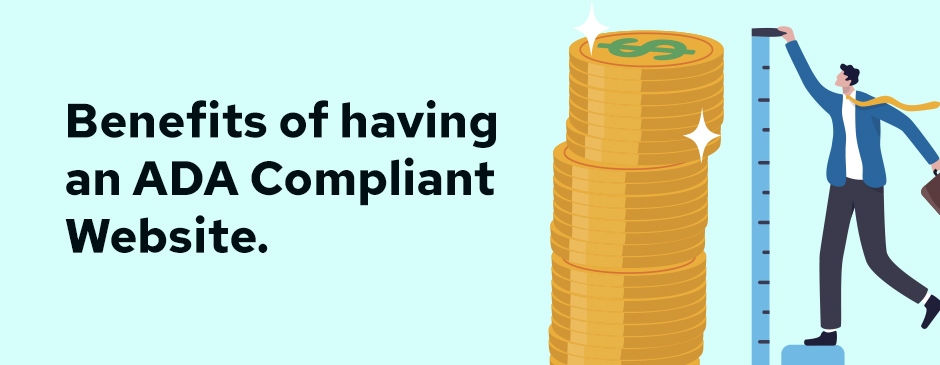
The internet, in its current state, is difficult (and sometimes nearly impossible) for individuals with disabilities to access. However, this is not the only reason that accessibility is important. There are additional, far-reaching advantages to creating universally accessible websites, which can benefit not only people with disabilities and those with websites but the majority of internet users in general:
- Avoids Legal Complications: If you build an accessible website, you can preempt any potential legal issues, such as claims of discrimination against people with disabilities, from arising. This will also ensure your organization can work with different groups or government agencies that require websites to be universally accessible.
- Creates a Better Site: Generally, universally accessible websites are of a higher caliber. Following guidelines for ADA compliance can help developers build a better website, as the guidelines tend to overlap with web design best practices.
- Improves Search Engine Optimization (SEO): Accessible websites can improve your search engine rankings. As mentioned above, Google gives priority to sites that are accessible; in addition, many accessibility features make it easier for search engines bots to evaluate your site, which can further boost your rankings
- Broadens Audiences: If your site is accessible, more people can use it. This can lead to more traffic, more users, and ultimately, more customers. While accessibility does not guarantee an increase in profits, it does provide an opportunity to garner a larger audience of users who may be interested in your business.
- Generates Positive PR: If your website is accessible, it can give a boost to your organization’s reputation, help you stand out from your competition, and demonstrate your passion for and dedication to being inclusive of everyone.
- Improves Usability for All: Accessibility makes websites easier to use, but that doesn’t only apply to people with disabilities, as non-disabled people can also benefit from sites that are more usable.
- Normalizes Accessibility: Websites designed with ADA compliance in mind help normalize accessibility. This, in turn, can help those working to meet accessibility needs across a variety of platforms.
A Brief Timeline of ADA Compliance and Websites:
1990 - ADA Signed into Law
The Americans with Disabilities Act prohibits discrimination based on disability in public life, including employment, education, transportation, and all public and private places that are open to the general public.
1998 - Section 508 Compliance Passed
The section 508 amendment requires federal agencies to make their “information and communication technologies” accessible to people with disabilities.
1999 - WCAG Published by the W3C
The W3C published the Web Content Accessibility Guidelines, also known as WCAG. The WCAG served as a roadmap for web developers who wanted their websites to be more accessible to users with disabilities. While heavily HTML-centric, WCAG 1.0 provided a much-needed framework for making the web and other digital technology accessible.
WCAG 1.0 consisted of 14 guidelines, each addressing a theme and describing how to apply it to particular website features.
- Provide equivalent alternatives to auditory and visual content.
- Don’t rely on color alone.
- Use markup and style sheets and do so properly.
- Clarify natural language usage.
- Create tables that transform gracefully.
- Ensure that pages featuring new technologies transform gracefully.
- Ensure user control of time-sensitive content changes.
- Ensure direct accessibility of embedded user interfaces.
- Design for device independence.
- Use interim solutions.
- Use W3C technologies and guidelines.
- Provide context and orientation information.
- Provide clear navigation mechanisms.
- Ensure that documents are clear and simple.
2008 - WCAG 2.0 guidelines Published
The next evolution of standardization came with the publication of the WCAG 2.0 guidelines in December 2008. The WCAG condensed its guidelines for web accessibility into four main principles, with recommendations for each.
Perceivable
- Provide text alternatives for non-text content.
- Provide captions and other alternatives for multimedia.
- Create content that can be presented in different ways, including by assistive technologies, without losing meaning.
- Make it easier for users to see and hear content.
Operable
- Make all functionality available from a keyboard.
- Give users enough time to read and use content.
- Do not use content that causes seizures.
- Help users navigate and find content.
Understandable
- Make text readable and understandable.
- Make content appear and operate in predictable ways.
- Help users avoid and correct mistakes.
Robust
- Maximize compatibility with current and future user tools.
Along with the WCAG 2.0 principles, there are also varying, testable levels of success criteria, known as Level A, Level AA, and Level AAA. These components help determine exactly how accessible a website is, with A being a low level of accessibility and AAA being a high level of accessibility. The type of business you operate determines whether your website should comply with Level A, AA, or AAA.
2017 - Section 508 of the Rehabilitation Act Updated
Section 508 of the Rehabilitation Act was updated to ensure federal agencies “develop, procure, maintain and use information and communications technology (ICT) that is accessible to people with disabilities
2018 - ADA Applies to Public Websites
The US Justice Department issued guidance that stated, “the ADA applies to public accommodations’ websites.” Requiring businesses to include those who are disabled or impaired in their virtual markets and public spaces is “consistent with the ADA’s Title III requirement that the goods, services, privileges, or activities provided by places of public accommodation be equally accessible to people with disabilities.”
Website Compliance
Compliance is not just about physically disabled users, it is about website accessibility for ALL users.
What are plaintiffs using as their reasons for lawsuits?
Inability to access all the website content. (specifically, anything tied to a process)
When websites aren’t coded correctly, screen readers get stuck, simply saying “image” or “blank” aloud, without continuing across the page. Proper headers and text embedded behind images help blind users navigate sites.
Compliance is designed to help two types of users:
- Physical - disabled users relying on screen readers and accessibility other tools.
- Financial - users with limited web access and tools. Users do not own a computer or are limited to public machines or mobile devices that may not have all the required tools installed. example: Adobe reader.
Levels of compliance
- A - Level A is the most basic and considered adequate for compliance.
- AA - Level AA will target additional website elements such as PDF documents and video files. Having youtube videos or PDF documents for download are two very common things that prevent a website from meeting the level AA compliance criteria. We highly recommend that these items are never required as part of a process. They can be extras or marketing tools, but not limit a user's ability to utilize your service or prevent them from accessing critical information about your services.
- AAA - This is the hardest level to achieve and will require many companies to completely rebuild, restructure, and rebrand for color-contrasting metrics, etc. This also limits website functionality and "wow" elements as they are not deemed accessible.
Level A is all that is required for compliance but we recommend hitting as many standards in level AA as possible.
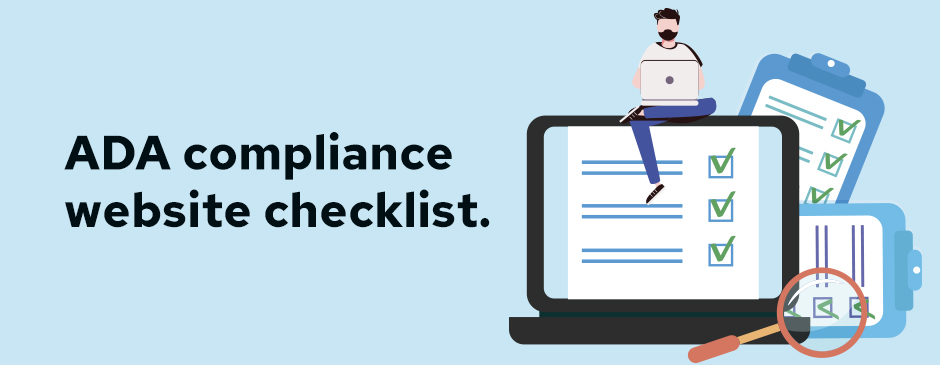
Because the need for and benefits of web accessibility can be overwhelming, you may not be aware of what you actually need to do to make your website ADA compliant. Planning for accessibility before developing your website is part of creating a thoughtful, deliberate, and high-quality web design. You can make changes to your site after its creation to improve accessibility, but for the best results, you should begin preparations as early in the design process as possible.
Below is a checklist of different website elements that you can use to make your website ADA compliant and more usable for people with disabilities:
Web Accessibility for Persons Who Vision Impaired
Though the elements listed here can be useful for anyone, people who have visual impairments—including people who are blind, have limited vision or are colorblind—have specific needs in terms of web accessibility and can benefit greatly from the following:
- Alternate Image Text: Images and videos on your site should have descriptive text attached to them. This allows screen readers to read that text, which then describes the image or video out loud. Good graphic design is more than just visually appealing content; it should always include this text in order to engage every visitor that comes to the site.
- Color Coding and Contrast: Color should not be the sole element used to convey meaning or information. There should also be adequate contrast between the color of the font and of the page, in order to make the text easier to read. You should also offer multiple color schemes so users can pick the one that they can see best.
- Descriptive Titles, Headers, and Links: All pages should have unique titles and headers, and all hyperlinks should have unique anchor text. Further, all titles, headers, and links should be descriptive of the associated information. Headers should also be formatted with heading style designations instead of changes in font, color, or size. Do not remove the underline from your hyperlinks.
- Flexible Text Size: Users should be able to change the font size on a page to make it either smaller or larger. Do not hardcode the size of your text on your website.
- Text Instead of Images for Important Information: Do not convey important or critical information with images; always use text, so text-to-speech readers can read it aloud. If you do have an important image or graphic, be sure to include alternate text or a description.
- Screen Reader Accessibility: Design your website so it can be easily read by screen readers and text-to-speech programs. Links, lists, and headers should be clearly identified with descriptive, non-generic terms. All language on the page should be concise and easy to read and appropriately identified so screen readers can clearly communicate the information on the page.
- Zoom Functions: Users should be able to use the zoom feature on your site, both on desktop and on mobile. Do not disable zoom functionality on either version of your site, and ensure that your layout can adapt to up to at least 200 percent zoom on desktop.
Web Accessibility for the Hearing Impaired
There are also ways you can improve your site’s accessibility for the hearing impaired community. Web accessibility best practices for these individuals include:
- Audio Transcripts: For all audio clips and videos on your site, provide a text-based transcript for users. You should also take care to ensure these transcripts are accessible to screen readers.
- Closed Captioning and Subtitles on Videos: You should provide closed captioning or subtitles, regardless of spoken language, on all of your videos. When using automated captioning software, make sure the captions are accurate and update them if necessary.
- Multiple Contact Options: When listing your contact information on your site, offer multiple methods of contact. Include your phone number and email address, at the very least. You could also provide a web form and physical or mailing address if needed.
- Simple English: Avoid jargon, uncommon words, and overly complex sentence structures. For many deaf and hard of hearing people, sign language is their first language, not English.
Accessible Web Design and Other Compliance Considerations
There are a great number of other accessibility features you should consider adding to your website. Many of these features are simply part of creating a high-quality website, and people will generally find them useful, whether or not they have a disability:
- Avoid Animations, Autoplay, and Popups: Animations, audio, and video clips on autoplay, pop-ups, and other automatic flashing or moving elements on a web page can be highly distracting or even potentially dangerous for some users. Always offer a warning before unexpected flashing or movement, and allow users to turn off these features on your site.
- Button and Link Size: Pay attention to the size of your buttons, links, and other touch targets on your site. People who aren’t using a mouse may have difficulty clicking on these items if they are too small. It’s equally important to make sure these elements are not too big, as users who have difficulties with motor control may accidentally click on something unintentionally.
- Keyboard Accessibility: Make your site fully accessible to those who only use a keyboard to navigate. Most sites allow users to navigate with a mouse, and many mobile sites allow for the use of touch screens, but keyboard accessibility is a necessity for many users.
- Avoid Multi-Touch Gestures: Think twice before requiring users to do more than one gesture at a time, or in quick succession, to utilize your website, particularly on your mobile site or app. Multi-touch gestures can be difficult or impossible for some users to do successfully.
- Avoid Purchase Time-Outs: Many sites will cancel a purchase if users take longer than a designated amount of time to complete it, but purchase time-outs pose large problems for users. Not only is it inconvenient to go through the process of adding things back into a cart, but some users may also take more time to do so than others.
- Skip Navigation Links: Allow keyboard-only users and screen readers to skip over repetitive content, such as your navigation or headers, to get directly to the main content of a page.
- Text Summaries: Whether or not they have a disability, some users cannot (or may struggle to) read long sentences or paragraphs. Break up the text into smaller paragraphs, use headers and subheaders to make it easier to read, or provide shorter summaries of the text.
Steps to Compliance
Testing is the first step. A competent web developer must test the website for ADA compliance. There are also some “free” internet testing tools available but these tests are fairly limited in scope and it may be risky to rely on only those tests to assure compliance. Regardless, they are an option.
We recommend that every property management company:
- Find a competent website developer that understands and adheres to the latest ADA compliance standards and guidelines
- Draft an “accessibility statement” for the website to demonstrate its commitment to accessibility and its work toward becoming fully ADA compliant,
- Ensure that all new or modified content added to the website is ADA compliant,
- Provide a way for visitors to request accessible information or services by posting a telephone number or email address on the home page and establish procedures that ensure a quick response to users with disabilities.
All website managers should also understand the basic tasks required for compliance. These issues also need to be addressed to make the website ADA compliant:
- The “language” used to develop the website (for example, semantic HTML (“hypertext mark-up language”) must be readily accessible to screen readers for the visually impaired).
- Headers and titles must appear in a rational order (screen readers will read the headers to help the visually impaired skip through sections easily until they find the information they are seeking).
- Text alternatives describing pictures on the page must be included.
- Captions on videos must be included for the hearing impaired.
- The ability to navigate using only the keyboard is the goal for both the visually and physically or neurologically impaired person using screen reading technology.
- Color and contrast need to be designed for visually impaired.
- Ability to make the font size 200% without distortion or loss of content.
Remediating Inaccessible Websites
Should you find your property management company in a litigious situation, courts do recognize that a website won’t become compliant quickly or easily. Demonstrating that a defendant is trying to convert its website is an important factor in defending a case or mitigating a penalty.
Once an accessibility audit has been conducted, and accessibility errors have been identified, the errors will need to be remediated in order to ensure the site is compliant with accessibility errors. The traditional way of correcting an inaccessible site is to go back into the source code, reprogram the error, and then test to make sure the bug was fixed. However, if the website is not scheduled to be revised in the near future, that error (and others) would remain on the site for a lengthy period of time, possibly violating accessibility guidelines. Because remediating a website is a complicated process, many website owners choose to build accessibility into a new site design and re-launch, as it can be more efficient to develop the site to comply with accessibility guidelines, rather than to remediate errors later.
Legislation on the Horizon
The intent of the law was to increase equal access for disabled persons not to spawn an entire class of new lawsuits.
In the 2017-2018 Congress, H.R. 620 was introduced. The bill would have (1) required the DOJ to develop a program to educate both government and private entities on strategies to promote access to public accommodations, and (2) require notice and ability to cure before suing.
108 Congressional representatives on a bi-partisan basis signed to support this Bill. It was passed in the House but the Senate took no action. Although H.R. 620 only addressed architectural barriers, it was on the right track. Industry trade associations should be encouraged to bring this bill up again with modifications to address the upgrading of social media and websites.
Meanwhile, the “new Frontier” of ADA litigation mandates taking steps now to convert industry member websites so they will either be, or be on the way to being, ADA compliant.
And, as always, please consult with your counsel for advice about specific ADA situations.
Additional Resources for Website ADA Compliance
For more information and further reading on website accessibility and ADA compliance, consult the following resources:
- ATbar: This browser toolbar allows users to change how they interact and view webpages.
- CommonLook Office Professional: This program allows users to convert Microsoft Word and PowerPoint files into section 508 compliant PDFs.
- Disability Language Style Guide: This guide goes over common terms related to disability and explains both offensive and preferred terminology.
- Google’s Resources for Developers and Publishers: This guide provides information on how Android and site developers alike can make their software and websites more accessible.
- Google’s Initiatives and Research on Web Accessibility: This resource center presents Google’s various initiatives and research related to web accessibility.
- Interactive Accessibility: This resource center offers a variety of information about disability and web accessibility.
- WebAIM.org: This organization works to ensure the web is accessible to all, provides resources and research on web accessibility and certifies websites that meet certain accessibility standards.
Web Content Accessibility Guidelines 2.0: These guidelines outline, in detail, the standards that websites should strive to meet in order to be accessible to all.

